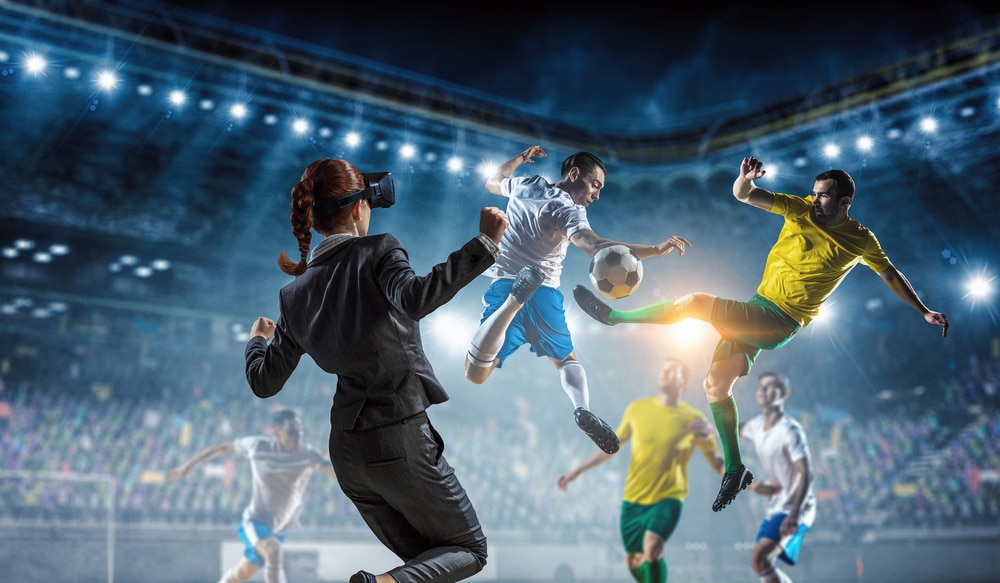In the digital age, technology has drastically transformed every aspect of life, and sports are no exception. From advanced performance analytics to augmented reality experiences, artificial intelligence (AI), and enhanced broadcasting capabilities, technology has reshaped the way we experience and engage with sports. The rapid evolution of these technologies has not only improved the experience for fans but also revolutionized how athletes train, how games are played, and how fans interact with their favorite sports teams and athletes.
The intersection of sports and technology has given rise to a new era in athletic performance, spectator engagement, and sports management. This article explores how technology is evolving the world of sports and what it means for the future of this global industry.
1. Enhanced Performance Analytics and Data-Driven Decisions
One of the most profound changes in sports in recent years has been the increased use of data analytics. Whether in football, basketball, soccer, or even esports, teams and athletes are using technology to gain a competitive edge through data collection and analysis.
Sports Analytics and Metrics:
Advances in technology allow coaches, managers, and analysts to collect real-time performance data during matches. The use of wearables and sensors, such as heart rate monitors, GPS trackers, and motion sensors, enables teams to track the physical performance of players, assessing their speed, endurance, and agility. These analytics can help identify strengths and weaknesses in an athlete’s game and offer data-driven insights into how to optimize their training and performance.
Big Data and Predictive Analysis:
The rise of big data has further transformed how teams and athletes approach competition. Through the use of machine learning algorithms, big data can predict player performance, analyze opponent strategies, and suggest optimal tactics. This predictive modeling is also used in injury prevention, where machine learning algorithms analyze biomechanical data to determine which players are at risk of injury, allowing coaches to modify their training routines and reduce injuries.
Fan Engagement Through Data:
Technology has also provided fans with new ways to interact with their favorite sports. Real-time statistics and in-depth analytics are now widely available through various apps and streaming platforms, giving fans insights into the games they watch. Fantasy sports leagues are another example of how data-driven decisions have reshaped the fan experience, allowing people to use real-time stats to build and manage their own teams.
2. Smart Equipment and Wearable Technology
Wearable technology has become an essential part of modern sports, both for professional athletes and casual fitness enthusiasts. These devices can track various metrics, including heart rate, steps taken, distance covered, and calories burned, providing valuable insights into an athlete’s performance and physical condition.
Smart Shoes and Clothing:
Companies like Nike, Under Armour, and Adidas are developing smart sports equipment, such as smart shoes and performance-tracking clothing, designed to measure an athlete’s movements and exertion. These technologies give athletes detailed feedback on their technique and performance, while coaches and trainers can use this data to provide better training regimens.
Wearable Sensors for Injury Prevention:
Wearable technology is also playing an important role in injury prevention. Devices like the Catapult Sports Tracker, worn by many professional athletes, monitor player performance and fatigue levels, alerting coaches if an athlete is at risk of injury. The integration of this technology helps athletes to adjust their intensity and training regimens to prevent overexertion and chronic injuries.
3. Virtual and Augmented Reality in Sports Training and Fan Experience
Virtual reality (VR) and augmented reality (AR) have also entered the world of sports, offering immersive and interactive experiences for both players and fans. These technologies are becoming essential tools in sports training, fan engagement, and even broadcasting.
Virtual Reality for Training:
Athletes are using VR technology to simulate game scenarios, practice skills, and enhance their decision-making abilities. For example, NFL quarterbacks use VR headsets to practice reading defenses in a simulated environment, allowing them to improve their reactions and mental preparedness without the physical toll of on-field practice. Similarly, soccer players use VR to enhance their tactical awareness by running through virtual game scenarios that allow them to experience and analyze different situations.
Augmented Reality for Fan Engagement:
AR is enhancing the fan experience by providing real-time statistics and interactive elements through mobile apps and smart glasses. Sports teams are using AR to engage fans in unique ways during live games, allowing them to view additional content, such as player stats, team history, and immersive replays through their devices. This creates a more dynamic and engaging experience at stadiums and arenas.
VR for Fan Experience:
Moreover, VR is taking fan engagement to the next level by allowing people to attend virtual live games from the comfort of their own homes. Some professional sports leagues, such as the NBA and MLB, have experimented with VR broadcasting, where fans can put on VR headsets and watch games as if they were sitting courtside or behind the dugout. This immersive experience brings fans closer to the action and opens up new avenues for sports broadcasting.
4. AI and Machine Learning in Sports Management
Artificial Intelligence (AI) and machine learning are playing a growing role in sports management, helping teams and organizations with strategic decision-making, game preparation, and even fan engagement.
AI for Match Analysis and Strategy:
AI is now being used to analyze team performance and provide tactical recommendations. By collecting and analyzing massive amounts of data on player movements, ball possession, and other game statistics, AI can assist in game strategy and help coaches identify key areas of focus for upcoming matches. Teams like FC Barcelona have integrated AI-powered tools that analyze opponent behavior and predict game outcomes.
Automated Highlights and Content Creation:
AI is also revolutionizing content creation in sports by enabling the automated generation of highlight reels. Platforms like IBM’s Watson are able to scan hours of game footage and automatically generate highlight clips, reducing the need for manual editing. This allows broadcasters to provide fans with real-time access to key moments from a game, making it easier for fans to engage with their favorite sports.
AI and Fan Experience:
AI chatbots are becoming increasingly popular in enhancing fan engagement, providing personalized responses to queries, offering ticketing services, and even assisting fans in finding game highlights. Some sports organizations are using AI-driven recommendation engines to suggest tailored content to fans, helping them discover games, news, and videos based on their individual preferences.
5. The Impact of Social Media and Digital Platforms on Sports
Social media and digital platforms have become critical for both athletes and teams in the modern sports landscape. The rise of social media has changed how sports are consumed, shared, and discussed worldwide, creating a new ecosystem for fans and athletes to interact.
Athletes as Social Media Influencers:
In the past, athletes were often isolated from the public, but social media platforms like Instagram, Twitter, and TikTok have turned athletes into global influencers. Through social media, athletes can build personal brands, connect with fans, and engage in marketing and sponsorship deals. The accessibility of athletes on these platforms has allowed fans to have a closer connection to their idols and has transformed the role of athletes in the entertainment industry.
Fan Interaction and Sports Content:
Social media has also democratized the way fans experience sports. Instead of relying solely on traditional broadcasting, fans can now share their thoughts, discuss games, and interact with their favorite teams and players online. Social media platforms have become a hub for fans to engage with exclusive content such as behind-the-scenes footage, interviews, and game previews.
Esports and the Rise of Online Communities:
Another area where digital platforms have had a profound impact is in esports. Esports, or competitive video gaming, has surged in popularity, with millions of fans tuning in to watch live streams on platforms like Twitch and YouTube. Esports teams, players, and tournaments have grown into global phenomena, with sponsorships and multi-million dollar prize pools driving the industry forward. As more traditional sports organizations look at esports as a potential revenue stream, the digital space will continue to redefine how sports and entertainment intersect.
Frequently Asked Questions (FAQs)
1. How is technology improving athlete performance?
Technology provides athletes with detailed analytics on their physical performance, including heart rate, speed, and recovery, helping them train more effectively. Wearable sensors and performance-tracking equipment also allow coaches to optimize training regimens and reduce the risk of injuries.
2. What role does virtual reality play in sports training?
Virtual reality (VR) allows athletes to simulate game situations, practice skills, and improve decision-making without the physical stress of on-field training. It is used in various sports like football, soccer, and basketball for tactical awareness and skill development.
3. How is AI used in sports strategy?
AI is used to analyze massive amounts of data, providing insights on team performance and opponent strategies. This helps coaches create effective game strategies, predict outcomes, and make data-driven decisions.
4. How do wearables help in injury prevention?
Wearables track metrics like fatigue, movement patterns, and exertion levels, providing real-time data that can alert coaches and athletes when a player is at risk of injury. This allows for modifications in training and workload to prevent injuries.
5. How is social media affecting sports fandom?
Social media has given fans unprecedented access to athletes and teams. It enables direct interaction, fan communities, and real-time engagement with content such as highlights, news, and behind-the-scenes footage.
6. What is the future of esports?
Esports has become a mainstream form of entertainment, with major tournaments and growing fan bases. The integration of esports into traditional sports leagues and increasing investment will continue to drive its growth.
7. How do AI and machine learning enhance sports broadcasting?
AI and machine learning are used to automate highlight creation, analyze game footage, and even predict key moments in a game. This technology enhances the viewing experience by offering more personalized and dynamic content.
Conclusion
The integration of technology into the world of sports is transforming the industry at an unprecedented rate. From performance analytics and smart equipment to AI-driven strategies, VR training, and social media engagement, technology is enhancing every aspect of sports. These advancements are not only benefiting athletes and teams but are also improving the fan experience, creating more interactive, personalized,
and immersive ways to engage with sports content.
As we look to the future, the role of technology in sports will only continue to expand. Whether it’s through further advancements in AI and VR or the continued growth of esports, the digital age is undoubtedly shaping the future of sports in ways we never thought possible.
Key Takeaway
Technology is driving a revolution in the sports industry. From training and performance optimization to fan engagement and content creation, innovations like AI, VR, and data analytics are transforming how athletes perform and how fans interact with sports. As technology continues to advance, the future of sports will be marked by even more immersive, data-driven, and accessible experiences for athletes and fans alike.

